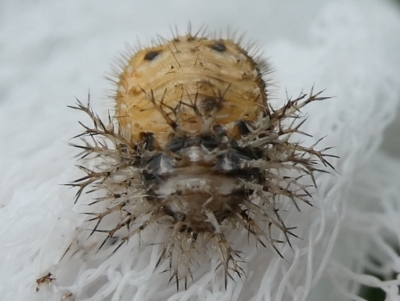Lady beetles (Coccinellidae)
There are 64 genera and 364 species of Coccinellidae described from Australia (Australian Faunal Directory, 2025)
A guide to the beetles of Australia by G. Hangay & P. Zborowski (CSIRO Publishing, 2010) lists the family's characteristics:
- body broadly ovate, highly convex, usually glabrous but some finely pubescent, 1-7 mm in length
- yellow to black, often bicoloured or spotted, some with metallic shine
- head deflexed, concealed from above by prothorax
- antennae short, usually 11-segmented, including a 3-segmented club
- tarsal formula [number of tarsal segments on front, middle and hind legs] 4-4-4, but appears to be 3-3-3 as the third segment is minute and hidden
Adults and larvae of most species are predators of aphids, mealybugs, scales or other small insects and mites. Exceptions are Epilachna species, which are herbivorous on Cucurbitaceae and Solanaceae, and Illeis galbula which feeds on powdery mildews (Australian beetles, Vol. 1, eds. J.F. Lawrence & A. Slipinski, CSIRO Publishing, 2013)
Announcements
There are currently no announcements.
Discussion
AlisonMilton
wrote:
28 Nov 2025
Hi Landimac, thanks for your sighting. The media you provided is missing. This can sometimes happen. Could you please add your photos again. Thanks.
Unverified Lady beetle (Coccinellidae)
Top contributors
- Hejor1 458
- AlisonMilton 347
- kasiaaus 85
- trevorpreston 51
- clarehoneydove 50
- ConBoekel 48
- MichaelBedingfield 44
- KylieWaldon 43
- Christine 41
- WendyEM 36
Top moderators
- AlisonMilton 1.3K
- MichaelMulvaney 319
- MichaelBedingfield 143
- DiBickers 100
- KimPullen 94
- KimberiRP 61
- Amata 51
- RogerF 27
- clarehoneydove 10
- donhe 9
























































